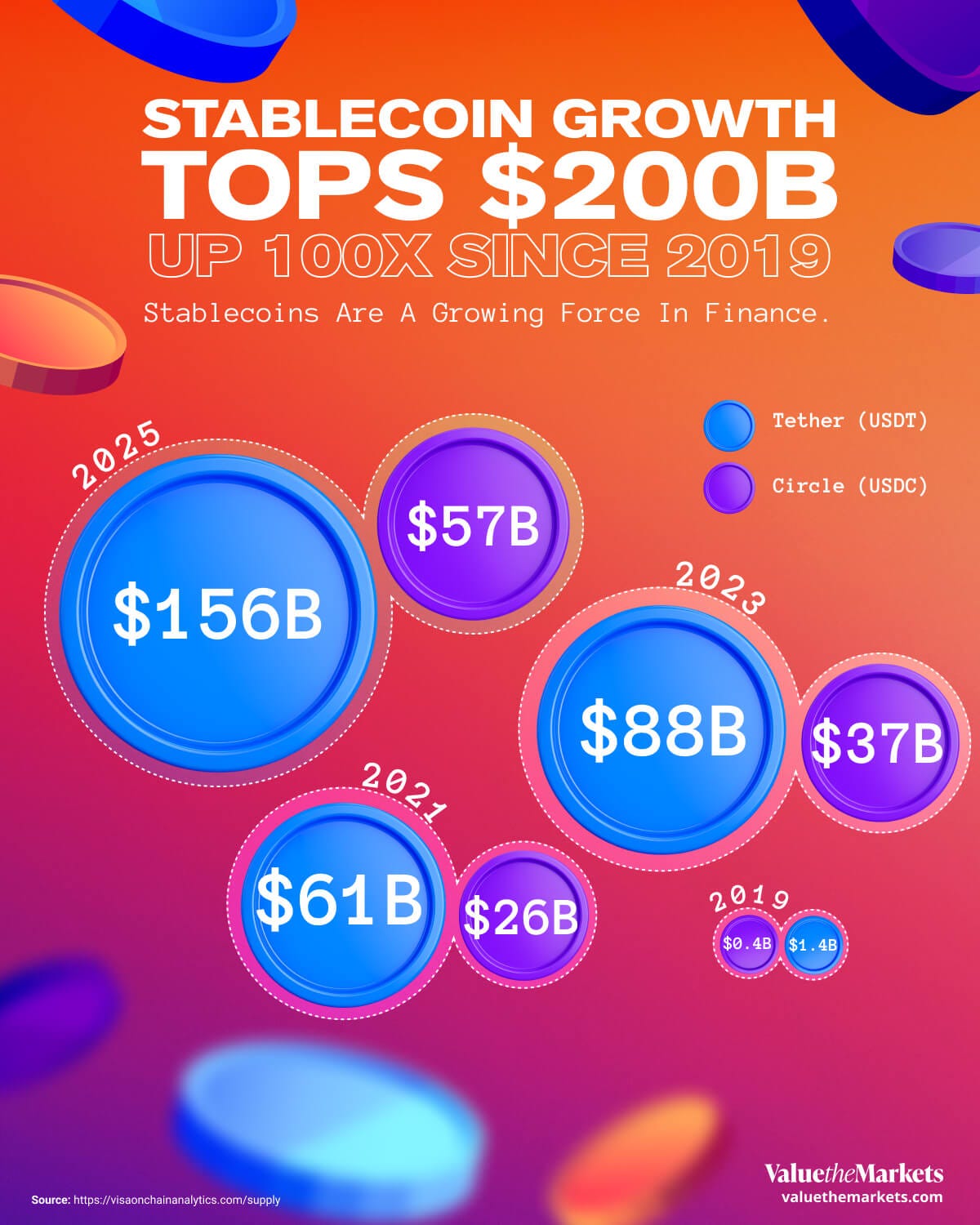🪙 Stablecoin Growth Tops $200B - Are You Missing Out? 🏦
Stablecoins are a growing force in finance.
Check out our Investing Data Story: Stablecoins Go Mainstream: What Investors Should Know
Stablecoins, crypto’s answer to the dollar, have quietly grown into a $200 billion force reshaping digital payments, investing, and the U.S. bond market.
Stablecoins were designed to tame crypto’s wild price swings. While Bitcoin and altcoins jump around in value, stablecoins stay mostly pegged to the US dollar, offering a safer way to move money on-chain without the volatility.
Why Not Just Use Dollars on the Blockchain?
The short answer is you can’t, at least not natively.
Traditional dollars are a part of the banking system. Blockchains like Ethereum or Solana are not designed to support government-issued currencies directly. That is why we need a blockchain-native version of the dollar.
That’s what stablecoins are. They're tokenized representations of the dollar, issued by private or decentralized entities and pegged 1:1 to USD. They give you the dollar’s stability with the blockchain’s speed and global access.
Here’s what that unlocks:
24/7 instant transactions across borders
Lower fees than wires or card networks
Access for anyone with a crypto wallet, no bank required
Integration with DeFi protocols for borrowing, lending, and earning
So, while you’re still using dollar value, you’re doing it without a bank, without permission, and without borders.
In the past, these tokens were primarily used by cryptocurrency traders. Today, companies like Visa, Mastercard, Amazon.com, Walmart and Meta Platforms are piloting and exploring their use. They're moving real money, fast, cheap, and globally, and are backed by billions in U.S. Treasurys. That means they're not just digital dollars, they're becoming powerful financial tools.
Stablecoins Now Major Players in Bond Markets
As of June 2025, Tether (USDT) holds approximately $156 billion in U.S. Treasuries, and Circle (USDC) holds $57 billion, making stablecoin issuers some of the largest non-governmental holders of U.S. debt.
This growing presence raises key questions about their impact on bond markets, especially during times of liquidity stress or rate shifts. It signals that stablecoins are no longer fringe assets, they are now part of the financial mainstream.
Why So Many Stablecoins?
Stablecoins all aim to stay near $1, but they vary in trust, structure, and purpose.
Trust and Transparency
Stablecoins differ in how they are backed. USDC is fully backed and audited, USDT is liquid but faces scrutiny, and DAI is decentralized and backed by crypto. Users choose based on how much trust they place in the issuer.
Network Fit
Different stablecoins work better in different ecosystems. USDC is common in US apps, DAI thrives in DeFi, and others like BUSD were tailored to platforms like Binance.
Centralization vs Decentralization
Some stablecoins can be frozen or blacklisted. Others, like DAI or FRAX, resist censorship. Users pick based on their priorities, compliance or control.
Innovation and Competition
Stablecoins compete on speed, cost, features, and yield. This drives innovation and gives users more options.
Some stablecoins, like FRAX, use hybrid or algorithmic models to maintain their peg without full dollar reserves, trading off some stability for decentralization and scalability.
The market supports many stablecoins because use cases, values, and technical needs all differ.
What’s Behind The Stablecoin Surge?
New regulation is driving momentum. The EU and Singapore have already set clear rules, and now the U.S. is stepping in. The Senate just passed the bipartisan GENIUS Act, which requires full asset backing, monthly reserve reports, and strict oversight, including for Big Tech.
If it becomes law this summer, it could pave the way for mainstream adoption, from paychecks to remittances to everyday purchases, all facilitated by stablecoins. This marks the beginning of a new financial system that retail investors cannot afford to ignore.
Stablecoin Market Outlook 2025
The stablecoin market is growing fast, with supply topping $200 billion and global regulation taking shape. Europe’s MiCA rules are live, Singapore and the UAE have frameworks in place, and the U.S. is moving forward with the GENIUS Act.
If passed, the Act could create a federally regulated market open to retail investors. Expect more tokenized funds, yield-bearing products, and integrations with platforms like Visa, PayPal, and Shopify.
This opens new ways to earn yield, access Treasurys, and use faster, cheaper payment rails. Risks remain, including regulatory gaps and uneven adoption, but stablecoins are now shaping real markets and are hard for investors to ignore.
How to Invest in Stablecoins
You can't buy a stablecoin stock yet, but there are other ways to get exposure:
Hold stablecoins on crypto platforms to earn yield, though regulation and protections vary.
Invest in public companies that build stablecoin infrastructure, such as payment processors or blockchain firms.
Look into blockchain funds or ETFs focused on digital finance.
Keep an eye on tokenized funds that turn Treasurys or money market assets into on-chain, retail-friendly products.
Read How to Invest in Stablecoins for more information.


Excellent overview — especially the framing of stablecoins as more than just crypto infrastructure. Their role in U.S. Treasury markets is a major development that traditional finance can’t afford to overlook.
As adoption widens, we’ll likely see deeper conversations emerge around oversight, stress scenarios, and the role of private money in public systems. https://blockscholesresearch.substack.com/